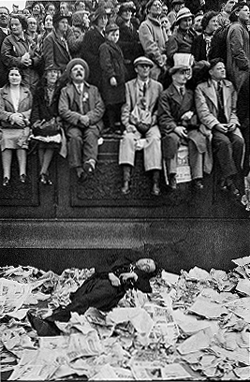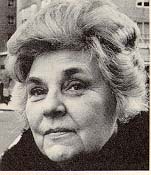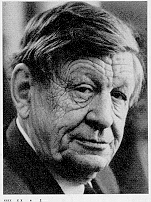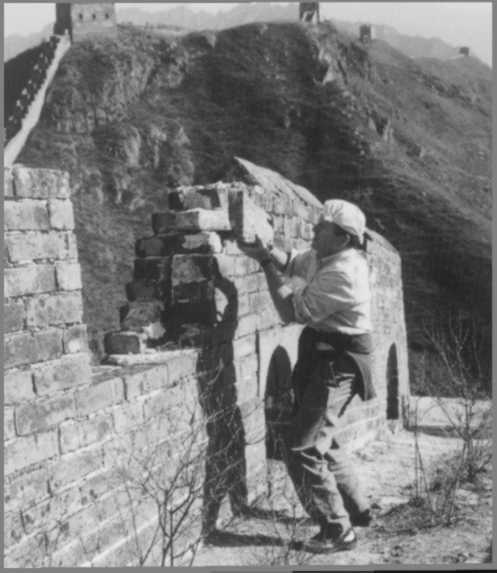Introduction
to Literature
Poetry IV: Society

Henri Cartier-Bresson,
Trafalgar Square on the day George VI was crowned: London 1938
from The Aperture History of Photography
Bk 1. NY: Aperture, 1976.
|
poetry--a critical voice
"Poetry... must stand at the opposite
pole to politics. It must 'recharge' the language when its strength has
been sapped by the debilitating effects of political and general misuse."
from
Poetry and Society
What kinds of pressures
do we experience from society in general? And from our society?
Do we need to overcome
the barriers, or shorten the distance, between modern people? Do
we say hi to our "neighbors"--or people we meet in an elevator?
|
|

"Autumn Begins
in Martins Ferry, Ohio"
Questions for 1. Understanding &
Analysis; 2. Application & Wild Association
the
text
1. Questions for Understanding & Analysis
-
This poem presents a speaker who is about to watch an American football
game. Do you know what football is? It might help you to look at the relevant
site below, which presents an explanation of the game and its rules. In
this poem a football game is used as a metaphor for life in society. In
what ways is life in society like a football game?
-
The first stanza presents various workers. Why are they dreaming
about heroes? Do they see themselves as heroes? Why do you think the
"Polacks" are slowly drinking their beers rather than going home?
Why are the faces of the negroes "gray"? Why are they "in" the furnace?
-
The second stanza suggests that the men introduced in the first
stanza are "ashamed to go home." Why? How do their jobs effect their
family life? Why do their wives feel unloved? Why are they like chickens?
-
If the second stanza shows how the men's jobs affect their relationships
with their wives, the third stanza shows how their children are affected.
Why do the sons play football? Are they too looking for love and human
contact? In what ways is playing football suicidal? In what ways is it
beautiful? Explain the final line.
-
What does the phrase "Their sons grow suicidally beautiful" mean?
What is the psychological relationship between the sons and their fathers?
(Cf. The McGraw Hill Introduction to Literature p. 473)
-
James Wright's father was a coal miner, and his youth was spent in a
blue-collar environment in the Midwest. How does the poem demonstrate
his knowledge of this aspect of America? (Cf. The McGraw Hill
Introduction to Literature p. 473)
-
What does this poem suggest about how individuals are effected by their
jobs and life in society?
Relevent Links and a biographical sketch:
James Wright was born in Martin's Ferry, Ohio in 1927 and died
of cancer in New York in 1980. He wrote with compassion about social
outcasts--criminals, prostitutes, and the insane--as well as politics,
nature, and human relationships. ...In a poem entitled "Many of our
Waters," Wright offers [a] comment on his goals:
The kind of poetry I want
to write is
The poetry of a grown man.
The young poets of New York
come to me with
Their mangled figures of
speech,
But they have little pity
For the pure clear word.
I know something about the
pure clear word,
Though I am not yet a grown
man.
And who is he?
Wright's "pure clear words" illustrate various poetic options available
to contemporary poets; he wrote both closed and open form poems ... (Ray
Schulte)
back to the top
¡@
Elizabeth
Bishop
"In the Waiting Room"
Relevant Links
|

Elizabeth Biship, Introduction
to Poetry p. 316
|
¡@¡""In
the Waiting Room"
Questions for 1.Understanding &
Analysis; 2. Application & Wild Association
the
text (her
paintings)
Questions for Understanding & Analysis
-
This poem presents the experience of a six-year-old girl as she goes to
the dentist's office with her aunt. Can you describe in your own words
the experience that she has? Have you ever had a similar experience? What
does the girl see in the magazine? How does she respond to what she sees?
-
When the girl hears her aunt cry out in pain she thinks ¡§that
it was me: / my voice, in my mouth¡¨ and ¡§I
was my foolish aunt, / I¡Xwe¡Xwere falling, falling¡K.¡¨
Why do you think the girl confuses and mixes herself and her identity with
that of her aunt?
-
In the second stanza the speaker tries to stay calm by reassuring herself
that she is all right, yet a new awareness of her own identity keeps returning
to her mind:
But I felt: you are an I,
you are an Elizabeth,
you are one of them.
Why should you be one, too?
What insight about herself is the girl just discovering?
-
The girl comes to recognize herself as a female. What does that mean for
her? Why does it frighten her?
-
What does the girl in this poem come to realize about herself as an individual
and a female in society?
Application &
Wild Association
-
Have you ever had a similar awareness with the girl's (see the above quote)?
How different is this girl's sense of identity from the speakers in Whitman's
"I saw in Louisianna a Live-Oak Growing," Dickensen's "I'm Nobody? Who
are you?" or Frost's "Mending Wall"?
-
The girl gets a sense of self-identity partly from reading the magazine
National
Geographics. When surfing on the web, what do you feel about
your self-identity? A Taiwanese, or citizen of the world?
Relevent Links:
back to the top
¡@
¡§Disillusionment
of Ten O'clock¡¨
Questions for 1.Understanding &
Analysis; 2. Application & Wild Association
E-Text;
Another
colorful version
Questions for Understanding & Analysis:
-
By ten o'clock in the evening many families are preparing for sleep. This
brief poem explores the pressures that attempt to make us conform to social
expectations, to be just like everyone else. What do you think the first
line of the poem means when it says ¡§The houses are haunted¡¨?
Are the people in the houses fully alive? Or are they half-alive, like
ghosts?
-
What are the connotations (see page 1534 in your textbook for a
definition of this term) for the color "white"? What do you think the poet
is suggesting by stating that the nightgowns in line two are white rather
than colorful?
-
What are "socks of lace"? What are "beaded ceintures"? Why are the people
in their houses not wearing such unusual clothes? Line seven in
the poem says that the people do not want to appear "strange"; why do they
not want to be different from everyone else?
-
The poem suggests that these people who are dressed the same and live the
same kinds of life, unwilling to be different or even to be themselves,
are also not free even in their dreams. Why are they not going to "dream
of baboons and periwinkles"?
-
The final three lines of the poem present a person who is not like the
people in the houses. How does that person differ from the rest of society?
What does it mean to catch tigers? What kind of animals are tigers? Are
they easy to catch? What qualities would a person need to catch them? What
do the tigers symbolize? Also what does ¡§red weather¡¨
mean? What are the connotations of red?
-
In this poem what does Wallace Stevens suggest about society? What does
he think individuals in society should do? What does the title suggest
about the people in the nightgowns and the sailor?
-
More
about literary techniques.
¡@Relevent
Link:
-
biography
(written by a student)
-
A
Wallace Stevens Site for both students and teachers,
including a photo gallery, a W. Stevens timeline, a course syllabus,
relevant links, etc.
-
Wallace
Stevens (a student project): including A Connecticut
Author? Biography, Pictures of Wallace Stevens, Chronology
of Events, Wallace Stevens in Hartford, More on Wallace Stevens, The Wallace
Stevens Writing Award, Bibliography
back to the top
| W. H. Auden
"The Unknown Citizen" (1940)
Relevant Links |

W. H. AudenIntroduction
to Poetry p. 311
|
"The
Unknown Citizen" (1940)
Questions for 1. Understanding &
Analysis; 2. Application & Wild Association
Questions for 1. Understanding &
Analysis
-
To help you understand this poem, you may want to know a little bit about
the monument for the unknown soldiers. For a brief explanation of this
famous tomb, see the relevant link below.
-
Who is the speaker of this poem? How would you describe him? What is important
to him? Do you think the poet's ideas about the "unknown citizen" being
described are the same as the speaker's view of him?
-
This poem uses much irony. Give an example of this irony and explain it.
-
The poem presents many facts about this individual. Briefly, what is known
about the man? In spite of all these facts, the man remains "unknown."
In what ways is he still "unknown"?
-
Explain the final two lines of the poem.
What does this poem suggest about our society and about individuals
in that society? In what ways is this poem a satire?
Application &
Wild Association
-
Is being an "unknown citizen" as Auden describes it the same with being
Dickensen's "nobody"?
-
Besides The Unknown Citizen," "Disillusionment of Ten O'clock,"
as
well as all the stories we have read ("The Lottery," "A & P," "A
Rose for Emily," "Paul's Case," "Yellow Wallpaper"), also deal with
social conformity. How are their perspectives different? What
are the ways offered in these texts to resist social conformity?
How do we strike a balance between insisting on our individuality and respecting
social norms? Or do we need to?
Relevent Links:
back to the top
Robert
Frost "Mending Walls" (1914)
|
Before Reading
What functions do you think "wall" usually serve? To separate
or protect us against the outside world? To mark boundaries or make
connections?
|
| |
|
After the 1st Reading:
- Main Idea and symbol:
-- Explain what the first line of this poem means to you. What
is the "something" here that "sends the frozen-ground-swell
under it"? Why does it not like the wall?
-- Mending Wall: How is the process of mending the wall described
(ll. 15-22)?'Stay where you are until our backs are turned!'
-- Does the wall stand for something else? Is it a symbol?
-- The poem contrasts two different ideas about "mending walls."
Describe them--the ideas and how they are expressed. Do you agree
that "Good fences make good neighbors"?
- Characters:
-- Do you agree with that idea or do you think that "Good fences make
good neighbours"? How is the neighbor described at the end of the
poem?
-- Describe the speaker of this poem and his values. Is humorous or
self-contradictory (or both)? (Why does the speaker repairs the holes
made by hunters, and inform his neighbor of the gaps if he does not
find the wall necessary? Why is Spring both a time for mending, and
creating mischief in the speaker? Why does the speaker wants to change
his neighbor? )
-- Besides the speaker and the neighbor, we can say that there are
two other "characters" (agents) in this poem: the "Something" which
does not like the wall, and the hunters (as a group). Compare
and contrast their attitudes toward the wall.
-- Examine the images (the neighbor as "old-stone savage"
and "in darkness"; the hunters "with yelping dogs";
the speaker with "Spring" and "Elves") associated
with these agents who are for or against the wall, and find out the
the meanings of the wall, as well as the speaker's attitudes toward
it.
|
| |
|
Further
Questions or After the 2nd Reading:
- Personification: Literally, the thing that breaks the wall
should be the frost on the wall. The speaker, however, calls it a
"Something" that actively "sends" the ground-swell,
"spills" the boulders, and "makes" gaps. Why?
- Poetic Form, and Sound and Sense:
-- the poem is a blank verse (any verse comprised of unrhymed lines
all in the same meter, usually iambic pentameter), so the meter is
iambic in general. What are the effects of the very regular iambic?
Are there exceptions (trochee or spondee)? For instance,
-- What's the sound effect of the hyphenated term with trochaic +
spondaic meters, "frozen-ground-swell"?
-- What's the sound effect of the regular meters here below?
We keep the wall between us as we go.
To each the boulders that have fallen to each. (ending with an anapest.)
- Structure and Repetition:
-- The poem can be divided into four parts: 1) the speaker's description
of Something's work vs. that of the hunters; 2) the speaker and neighbor's
walking the line; 3) The speaker's two attempts at persuading the
neighbor; 4) Conclusion with "Something" and a symbolic
depiction of the neighbor. Examining the four parts, can you find
any repeated lines? What are the functions of their repetition?
-- This poem has other repetitions in iambic pentameter (e.g. "To
each the boulders that have fallen to each/And some are loaves and
some so neatly balls" ). What are the effects of the repetitions
and regularity in form?
|
| |
|
Extension:
|
Relevent links:
back to the top
![]()


